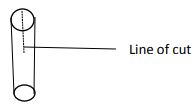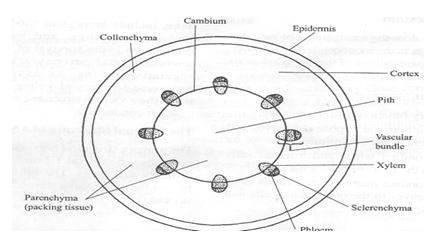Questions
INSTRUCTIONS TO CANDIDATES
- Answer ALL questions
- You are required to spend the first 15minutes of the 1 ¾ hours allowed for this paper reading the whole paper carefully before commencing your work.
- You are provided with a specimen labelled K,Using the scapel cut 8 cm of the petiole from the side close to the lamina.cut 2 pieces each measuring 4cm. using a scapel cut a slit halfway through the middle of each piece as shown in the diagram below.
Place one piece in solution labelled A and the other in solution labelled B.Allow the set up to stand for 30 minutes.- After 30 minutes remove the pieces and press each gently between the fingers.
- Record your observations (2mks)
- solution A
- Solution B
- Account for the observations .made in the petiole dipped in solution A. (3mks)
- Record your observations (2mks)
- Explain the role of the physiological process identified above in plant nutrition (2mks)
- State the sub-division to which the plant from which specimen K was obtained belongs. (2mks)
- State TWO observable features that adapt specimen K for gaseous exchange (2mks)
- cut a transverse section of the petiole , using a hand lens observe the arrangement of the vascular bundles and make a diagram of the same. (3mks)
- After 30 minutes remove the pieces and press each gently between the fingers.
- You are provided with two bones labelled .Examine them and answer the questions below
- Giving reasons, identify bones W and Q (4mks)
- Identity of bone W
Reasons - Identity of bone Q
Reasons
- Identity of bone W
- State TWO adaptations of specimen Q (2mks)
- Bone Q and Bone W articulate , draw a diagram showing how the two bones articulate. (5mks)
- State the significance of the articulation of the TWO bones. (2mks)
- Giving reasons, identify bones W and Q (4mks)
- The photograph below show stages in cell division.
- Name the stages represented by the cells labelled X, Y and Z (3mks)
- State the significance of the above cell division to an organism. (3mks)
- Name TWO regions in higher plants where the above process occur (2mks)
- Explain the events that take place in the phase after phase Y. (3mks)
- State the importance of the above in a member of a species (2mk)
Confidential
- The information contained in this paper is to enable the head of school and teacher in charge of Biology to make adequate preparations for this year’s Biology mock practical examination. NO ONE ELSE should have access to this paper or acquire knowledge of its contents. Great care must be taken to ensure that the information herein does not reach the candidates either directly or indirectly.
- The Biology teacher is NOT expected to perform the experiments
- The apparatus required by each candidate for the Biology mock practical examination are set out on the next page. It is expected that the ordinary apparatus of a Biology laboratory will be available.
- The Biology teacher should note that it is his/her responsibility to ensure that each apparatus acquired, for this examination agrees with specifications on the next page.
Each candidate will require the following:
- Freshly plucked kale leaf with a petiole at least 10cm long.
- 50ml of 2M sodium chloride solution in beaker labeled solution A.
- 50 ml distilled water in a beaker labeled solution B.
- 2 petri dishes.
- Scapel.
- Hand lens.
- Ruler.
- Bone W, which is Thoracic vertebrae.
- Bone Q, which is Rib.
Marking scheme.
- You are provided with a specimen labelled K,Using the scapel cut 8 cm of the petiole from the side close to the lamina.cut 2 pieces each measuring 4cm. using a scapel cut a slit halfway through the middle of each piece as shown in the diagram below.
Place one piece in solution labelled A and the other in solution labelled B.Allow the set up to stand for 30 minutes.- After 30 minutes remove the pieces and press each gently between the fingers.
- Record your observations (2mks)
- solution A
- Firm/stiff/hard/rigid
or - the split curves considerably with the epidermis on the inside circumference and the cortex on the outside circumference.
- Firm/stiff/hard/rigid
- Solution B
- Soft/flexible/flabby/limber
or - the split curves slightly with the epidermis on the outside circumference and the cortex on the inside circumference.
- Soft/flexible/flabby/limber
- solution A
- Account for the observations made in the petiole dipped in solution A. (3mks)
- Liquid A is hypotonic, cells take in water by osmosis and become turgid.
or - Liquid A is hypotonic; epidermis cells are covered by a cuticle. Hence take in water by osmosis at a very small rate.
Cortical cells have no cuticle hence they take in a lot of water by osmosis and expand, the differential expansion between cortical cells results in a curvature of the slit with the epidermis on the inner circumference.
- Liquid A is hypotonic, cells take in water by osmosis and become turgid.
- Record your observations (2mks)
- Explain the role of the physiological process identified above in plant nutrition (2mks)
- feeding insectivorous plants
- State the sub-division to which the plant from which specimen K was obtained belongs. (2mks)
- Subdivision Angiospermae/Angiospermatophyta
- Reason: Broad leaf
- State TWO observable features that adapt specimen K for gaseous exchange (2mks)
- It has a broad, flat lamina that offers a large surface area for gaseous exchange.
- It is thin, hence reducing the distance over which diffusion of gases from the atmosphere to the innermost cells takes place.
- cut a transverse section of the petiole , using a hand lens observe the arrangement of the vascular bundles and make a diagram of the same. (3mks)
- After 30 minutes remove the pieces and press each gently between the fingers.
- You are provided with two bones labelled .Examine them and answer the questions below
- Giving reasons, identify bones W and Q (4mks)
- Identity of bone W
- Thoracic vertebra.
Reasons - Has a long and broad neural spine.
- Short transverse processes
- Presence of demifacets/capitulum and tuberculum for articulating with the ribs.
- Thoracic vertebra.
- Identity of bone Q
- Rib
Reasons - It is long, flattened and curved
- It has tuberculum and capitulum /points of attachment to the thoracic veterbrae.
- Rib
- Identity of bone W
- State TWO adaptations of specimen Q (2mks)
- It is long, flattened and curved.
- It has tuberculum and capitulum /points of attachment to the thoracic veterbrae.
- Bone Q and Bone W articulate , draw a diagram showing how the two bones articulate. (5mks)
- State the significance of the articulation of the TWO bones. (2mks)
- The articulation provides a surface for breathing
- Giving reasons, identify bones W and Q (4mks)
- The photograph below show stages in cell division.
- Name the stages represented by the cells labelled X, Y and Z (3mks)
- X –MATAPHASE 1
- Y.-PROPHASE 1
- Z-ANAPHASE 1
- State the significance of the above cell division to an organism. (3mks)
- Results in the formation of gamete cells which are involved in sexual reproduction
- Maintains the diploid number of chromosomes in the organisms.
- Source of genetic variations, as it enables mixing of genetic material during crossing over at prophase 1
- Name TWO regions in higher plants where the above process occurs (2mks)
- Anthers
- Ovaries
- Explain the events that take place in the phase after phase Z. (3mks)
- .The spindle fibers disappear
- .The cell membrane constricts across the middle
- A nucleolus forms in each new nucleus
- State the importance of the process taking place in Y in a member of a species (2mk)
- Exchange of genes resulting to variations.
- Name the stages represented by the cells labelled X, Y and Z (3mks)
Join our whatsapp group for latest updates
Tap Here to Download for 50/-
Get on WhatsApp for 50/-
Download Biology Paper 3 Questions and Answers with Confidentials - KCSE 2021 Westlands Mock Exams.
Tap Here to Download for 50/-
Get on WhatsApp for 50/-
Why download?
- ✔ To read offline at any time.
- ✔ To Print at your convenience
- ✔ Share Easily with Friends / Students




